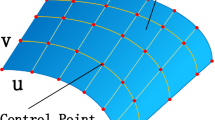Abstract
Feature recognition systems are now widely identified as a cornerstone for conceiving an automated process planning system. Various techniques have been reported in the literature, but a few of them acquired a status of generic methodology. A flexible and robust approach is demanded for recognising a wide variety of features, e.g., non-interacting, interacting circular and slanting features. This research aims to exploit the concept of the ray - firing technique, in which a 2D surface pattern for each feature is generated and information is extracted from these patterns to correlate it with the corresponding machining features. The system first defines a virtual surface and then probing rays are dropped from each point of this surface to the 2.5D features of the B-rep solid model. According to the length of rays between the bottom face of the 2.5D machining features and the virtual surface, 2D feature patterns are formed for each machining feature. Finally, features are recognised using an algorithm described in this article. Different types of examples have been considered to demonstrate the effectiveness of the proposed approach.
Similar content being viewed by others
References
Zhang HC, Alting L (1994) Computerised manufacturing process planning systems. Chapman and Itall, London
Sommerville MGL, Clark DER, Corney JR (1995) Viewer-centered geometric feature recognition, 4th ACM Symposium on solid modelling (ACM Press) pp. 125-129
Grayer AR (1975) A computer link between design and manufacture. Ph.D. thesis, University of Cambridge, UK
Kyprianou LK (1980) Shape classification in computer aided design. Ph.D. thesis, University of Cambridge, UK
Woo TC (1982) Feature extraction by volume decomposition, In: proceedings of the conference on CAD/CAM, pp. 39-45
Kim YS (1992) Recognition of form features using convex decomposition. Comput Aided Des 24(9):461-476
Wang MT, Chang TC (1990) Feature recognition for automated process planning. Proc Manuf Int 90(2):49-54
Tseng YJ, Joshi S (1994) Recognising multiple interpretations of intersecting machining features. Comput Aided Des 26(9):667-688
Karinthi R, Nau D (1992) An Algebraic Approach to feature interactions, IEEE Trans Pattern Anal Mach Intell 14(4):469-484
Shen Y, Shah JJ (1998) Recognition of machining features based on HSPCE decomposition, feature composition and process centred classification. Trans ASME J Mech Des 120:668-677
Bidarra R, Dekraker K, Broonsvoort W (1998) Representation and management of feature information in a cellular model. Comput Aided Des 30(4):301-313
Henderson MR (1984) Extraction of feature information from three- dimensional CAD data. Ph.D. thesis, Purdue University
Kung H (1984), An investigation into development of process plans from solid geometric modelling representations. Ph.D. thesis, Oklahoma State University
Dong X (1988) Geometric feature extraction for computer aided process planning, Ph.D. thesis, Rensselar Polytechnic Institute
Florini DE, Falcidieno (1987) Extraction and organisation of form features into a structured boundary model. North Holland, Amsterdam
Gavankar P, Henderson MR (1995) Graph – based extraction of two- connected morphological features from boundary representations”, J Intell Manuf 6:401-413
Joshi S, Chang TC (1988) Graph- based heuristics for recognition of machined features from a 3D solid model. Comput Aided Des 20(2):58-66
Corney J, Clark D (1991) Methods for finding holes and pockets that connect multiple faces in 2.5 D objects. Comput Aided Des 23:658-798
Kumar AS, Salim FK, Nee AYC (1996) Automatic recognition of design and machining features from prismatic parts. Int J Adv Manuf Technol 11:136-145
Lee YC, Fu KS (1987) Machine understanding of CSG: Extraction and unification of manufacturing features. IEEE Comput Graphics Appl 20-32
Gao S, Shah JJ (1998) Automatic recognition of interacting machining features based on minimal condition sub-graph. Comput Aided Des 30(9):727-739
Vandenbrande JH, Requicha AAG (1993) Spatial reasoning for the automatic recognition of machinable features in solid models. IEEE Trans Pattern Anal Machine Intell 15(12):1269-1285
Han J, Requicha AAG (1997) Integration of feature - based design and feature recognition, Comput Aided Des 29(5):393-403
Laakko T, Mantyla (1993) Feature modelling by incremental feature recognition. Comput Aided Des 25(8):479-492
Venuvinod PK, Wong SY (1995) A graph based expert system approach to geometric feature recognition. J Intell Manuf 6:155-162
Qamhiyah AZ, Venter RD, Benhabib B (1996) Geometric reasoning for the extraction of form features. Computer Aided Des 28(11):887-903
Gahd R, Prinz FB (1993) Recognition of geometric forms using the differential depth filter. Comput Aided Des 24(11):583-598
Li WD, Ong SK, Nee AYC (2003) A hybrid method for recognizing interacting machining features. Int J Prod Res 41(9):1887-1908
Sommerville MGL (1996) Viewer-Centred geometric feature recognition. Ph.D. thesis, Heriot-Watt University, UK
Sommerville MGL, Clark DER, Corney JR (2001) Viewer-centered geometric feature recognition. J Intell Manuf 12:359-375
Author information
Authors and Affiliations
Corresponding author
Rights and permissions
About this article
Cite this article
Ranjan, R., Kumar, N., Pandey, R. et al. Automatic recognition of machining features from a solid model using the 2D feature pattern. Int J Adv Manuf Technol 26, 861–869 (2005). https://doi.org/10.1007/s00170-003-2059-2
Received:
Accepted:
Published:
Issue Date:
DOI: https://doi.org/10.1007/s00170-003-2059-2




